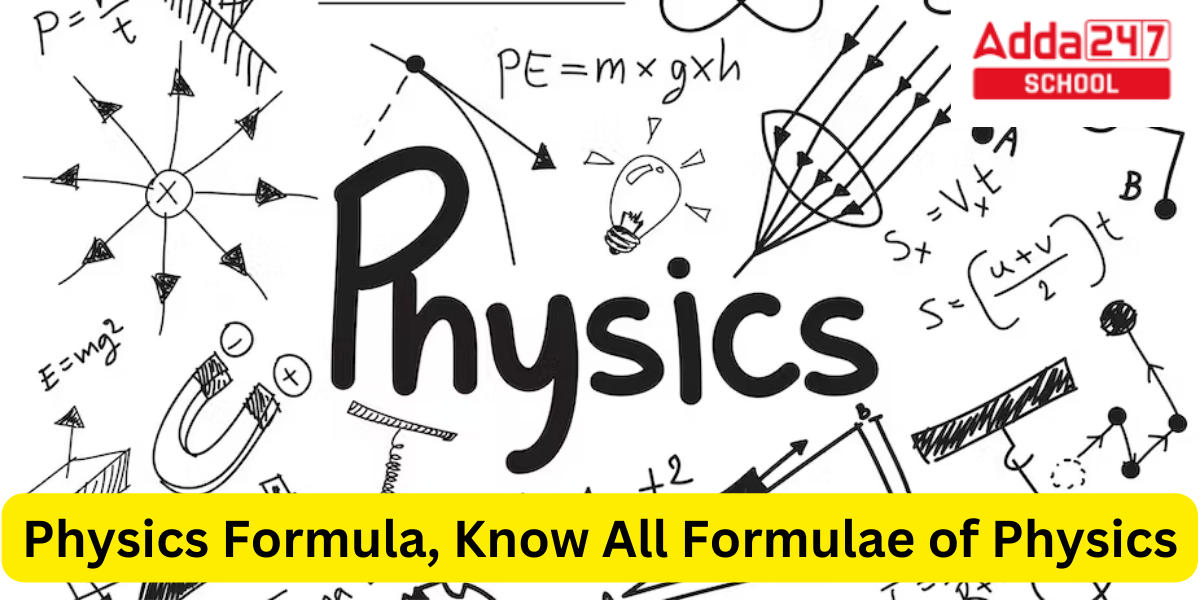Table of Contents
Physics formulas are very important for students of Classes 10 and 12. Physics formula will help to do fast calculations and get good scores in board exams. here we discuss about some physics formulas which are really important in daily life.
Physics Formulas
Physics Formulas are very useful for all NEET and JEE aspirants. Some Basic Physics formulas are given below.
- Planck constant h = 6.63 × 10−34 J.s = 4.136 × 10–15 eV.s.
- Gravitation constant G = 6.67×10−11 m3 kg−1 s−2
- Boltzmann constant k = 1.38 × 10−23 J/K.
- Molar gas constant R = 8.314 J/(mol K)
- Avogadro’s number NA = 6.023 × 1023 mol−1
- Charge of electron e = 1.602 × 10−19 C.
Physics Formula
Physics is a fascinating branch of science that studies the fundamental principles governing the behavior of matter and energy in the universe. It is a field that relies heavily on mathematical physics formulae to explain various phenomena. this physics formula includes, From the basic equations of motion to the more complex laws of thermodynamics, the following are some of the most important formulae of physics that every student and enthusiast should know. Check below in this article some physics formulas.
Physics Basic Formulas
- Newton’s Laws of Motion: These three laws are the foundation of classical mechanics and describe the motion of objects. They are as follows:
- First Law: An object at rest will remain at rest, and an object in motion will continue in motion with a constant velocity unless acted upon by an external force.
- Second Law: The acceleration of an object is directly proportional to the force acting on it and inversely proportional to its mass. F = ma.
- Third Law: For every action, there is an equal and opposite reaction.
- Law of Universal Gravitation: This law states that every particle in the universe attracts every other particle with a force that is directly proportional to the product of their masses and inversely proportional to the square of the distance between them. F = G(m1m2/r^2), where G is the gravitational constant.
- Coulomb’s Law: This law describes the electrostatic force between charged particles. It states that the force between two charged particles is directly proportional to the product of their charges and inversely proportional to the square of the distance between them. F = k(q1q2/r^2), where k is the Coulomb constant.
- Ohm’s Law: This law relates the voltage, current, and resistance in an electrical circuit. It states that the current flowing through a conductor between two points is directly proportional to the voltage across the two points and inversely proportional to the resistance between them. V = IR.
- Einstein’s Mass-Energy Equivalence: This equation relates mass and energy and is expressed as E = mc^2, where E is energy, m is mass, and c is the speed of light.
- Boyle’s Law: This law describes the relationship between the volume and pressure of a gas at a constant temperature. It states that the product of the pressure and volume of a gas is constant. PV = k.
- Ideal Gas Law: This equation describes the behavior of an ideal gas under various conditions. It relates the pressure, volume, temperature, and number of moles of a gas. PV = nRT, where R is the gas constant.
- Stefan-Boltzmann Law: This law relates the total energy radiated per unit area of a black body to its temperature. It is expressed as E = σT^4, where σ is the Stefan-Boltzmann constant.
- Snell’s Law: This law describes the refraction of light as it passes through a boundary between two different media. It states that the ratio of the sine of the angle of incidence to the sine of the angle of refraction is constant. n1sinθ1 = n2sinθ2, where n is the refractive index of the medium.
Physics Formula Class 12
Because it aims to comprehend the fundamental principles governing the cosmos, physics is frequently referred to as the fundamental science. Physics formulae, which are sophisticated equations that capture the laws of nature, are at the core of this science. These formulas hold the key to solving the riddles of the physical world; they are not merely meaningless symbols. Some of the most important formulas of physics for class 12 is given below.
- work = F. S cosΘ, where F = force, s = displacement
- kinetic energy = (1/2)m. v² = p²/2m, where m = mass and p = momentum
- potential energy = m. g. h, where m = mass, h = height
- spring potential energy = (1/2)k. x², where x = displacement in the spring
- gravitation potential energy = -(G . M. m)/d
- v = u + a. t, where a= acceleration, u = initial velocity, v = final velocity, t = time
- s = u. t + (1/2)a. t², where s = displacement
- v² = u² + 2. a. s
- dot product of two vectors= a. b. cosΘ
- cross product of two vectors = a. b. sinΘ
- gravitation force = (G . m1. m2)/d², where G is the gravitational constant, m1, m2 are two masses and d is the distance between them
- angle of reflection = angle of incidence
- focal length (f) = R/2, where R = radius of curvature
- mirror formula: (1/f) = (1/v) + (1/u), where v = image distance from the focus, u = object distance from the focus
- magnification formula: m = -v/u
Physics Formula Sheet Class 12
Here is a list of some important physics formulas that are commonly covered in a Class 12 physics curriculum. These formulas cover various topics such as mechanics, electromagnetism, optics, thermodynamics, and more. Keep in mind that this list is not exhaustive, and you should refer to your textbook and class notes for a comprehensive set of formulas.
Physics Basic Formulas for Mechanics:
- Newton’s Second Law: F = ma (Force equals mass times acceleration)
- Gravitational Force: F = G * (m1 * m2) / r^2 (Universal law of gravitation)
- Work-Energy Theorem: W = ΔK (Work done equals change in kinetic energy)
- Conservation of Linear Momentum: p = mv (Momentum equals mass times velocity)
- Conservation of Angular Momentum: L = Iω (Angular momentum equals moment of inertia times angular velocity)
- Conservation of Energy (Mechanical Energy): E = K + U (Total mechanical energy equals kinetic energy plus potential energy)
Physics Basic Formulas for Electromagnetism:
- Coulomb’s Law: F = k * (q1 * q2) / r^2 (Force between two point charges)
- Electric Field: E = F / q (Electric field strength equals force per unit charge)
- Gauss’s Law: ΦE = q / ε₀ (Electric flux equals charge divided by permittivity of free space)
- Ohm’s Law: V = IR (Voltage equals current times resistance)
- Magnetic Force on a Moving Charge: F = qvB sin(θ) (Force on a moving charge in a magnetic field)
- Faraday’s Law of Electromagnetic Induction: ε = -dΦB / dt (Induced electromotive force due to changing magnetic flux)
- Lenz’s Law: The direction of the induced current opposes the change in magnetic flux that produced it.
Physics Basic Formulas for Optics:
- Snell’s Law: n₁sin(θ₁) = n₂sin(θ₂) (Relation between angles and refractive indices in a medium)
- Lens Formula: 1/f = 1/v – 1/u (Relation between focal length, object distance, and image distance for lenses)
- Mirror Formula: 1/f = 1/v + 1/u (Relation between focal length, object distance, and image distance for mirrors)
- Magnification: m = -v/u (Relation between image distance and object distance)
- Young’s Double-Slit Interference: λ = (d * sin(θ)) / m (Interference pattern in double-slit experiment)
Physics Basic Formulas for Thermodynamics:
- First Law of Thermodynamics: ΔU = Q – W (Change in internal energy equals heat added minus work done)
- Second Law of Thermodynamics: Heat flows spontaneously from hotter to colder bodies; entropy increases in isolated systems.
- Ideal Gas Law: PV = nRT (Relation between pressure, volume, amount of gas, gas constant, and temperature)
- Carnot Efficiency: η = 1 – (Tc / Th) (Efficiency of a Carnot heat engine)
Remember that understanding the concepts behind these formulas is crucial. Simply memorizing formulas might not be enough to excel in physics. Practice applying these formulas to various problems and scenarios to gain a deeper understanding of their applications.
Physics all Formulas List
Below is the list of important Physics Formula:
Physics Formulas of Mechanics
- Kinematics:
- v = u + at
- s = ut + 1/2 at^2
- v^2 = u^2 + 2as
- Newton’s Laws of Motion:
- F = ma
- F = Gm1m2/r^2 (Law of Universal Gravitation)
- Work, Energy and Power:
- W = Fd cosθ
- K = 1/2 mv^2
- P = W/t
- P = Fv cosθ
- ΔU = Q – W
- Momentum and Impulse:
- p = mv
- FΔt = Δp
- Rotational Motion:
- τ = rFsinθ
- ω = Δθ/Δt
- α = Δω/Δt
- K = 1/2 Iω^2
Physics Formulas of Thermodynamics
- Ideal Gas Law:
- PV = nRT
- First Law of Thermodynamics:
- ΔU = Q – W
- Second Law of Thermodynamics:
- ΔS = Q/T
- Heat Transfer:
- Q = mcΔT (specific heat capacity)
- Q = mL (latent heat)
Physics Formulas of Electromagnetism
- Coulomb’s Law:
- F = kq1q2/r^2
- Electric Field:
- E = F/q
- E = kq/r^2
- Electric Potential:
- V = kq/r
- ΔV = Ed
- Capacitance:
- C = Q/V
- Ohm’s Law:
- V = IR
- Magnetic Field:
- F = qvBsinθ
- B = μ0I/2πr
- Faraday’s Law of Induction:
- ε = -ΔΦ/Δt
- Maxwell’s Equations:
- ∇·E = ρ/ε0
- ∇·B = 0
- ∇×E = -∂B/∂t
- ∇×B = μ0J + μ0ε0∂E/∂t
Physics Formulas of Optics
- Snell’s Law: n1sinθ1 = n2sinθ2
- Lens Equation: 1/f = 1/do + 1/di
- Magnification: m = -di/do
- Interference: Δx = λd/D
Physics Formulas of Waves
- Wave Speed: v = λf
- Frequency and Period: f = 1/T
- Wavelength and Wave Number: k = 2π/λ
- Wave Intensity: I = P/A
Physics Formulas of Atomic and Nuclear Physics
- Planck’s Constant: E = hf
- De Broglie Wavelength: λ = h/p
- Rydberg Formula: 1/λ = R (1/n1^2 – 1/n2^2)
- Binding Energy: E = mc^2
Physics Formulas of Relativity
-
- Time Dilation: Δt = Δt’ / √(1 – v^2/c^2)
- Length Contraction: L = L’√(1 – v^2/c^2)
- Mass-Energy Equivalence: E = mc^2
Physics Formulas of Fluid Mechanics
- Bernoulli’s Equation: P + 1/2ρv^2 + ρgh = constant
- Continuity Equation: A1v1 = A2v2
- Poiseuille’s Law: Q = πr^4ΔP/8ηL
- Reynolds Number: Re = ρvd/η
Physics Formulas of Thermodynamics
- Entropy: ΔS = Q/T
- Efficiency: η = W/Qh
- Carnot Cycle Efficiency: η = 1 – Tc/Th
Physics Formulas of Electricity and Magnetism
- Ampere’s Law: ∫B·ds = μ0I
- Gauss’s Law: ∮E·dA = Qenc/ε0
- Inductance: V = -L (dI/dt)
- Capacitive Reactance: Xc = 1/(2πfC)
Physics Formulas of Atomic and Nuclear Physics
- Half-Life: t1/2 = 0.693/λ
- Decay Constant: λ = ln2/t1/2
- Binding Energy per Nucleon: BE/A = Δmc^2/A
Physics Formulas of Quantum Mechanics
- Uncertainty Principle: ΔxΔp ≥ h/4π
- Schrödinger Equation: HΨ = EΨ
- Energy Levels of Hydrogen Atom: E = -13.6eV/n^2
Physics Formula for Important Topics of Physics
Physics is a natural science that deals with the study of matter, energy, and the relationship between them. It is one of the most fundamental sciences, providing us with a deep understanding of the universe and its workings. There are many important topics in physics, some of which have been studied for centuries, while others are relatively new. In this article, we will explore some of the most important topics in physics and their significance.
- Mechanics: Mechanics is the branch of physics that deals with the study of motion, forces, and energy. It is the foundation of all other branches of physics. Mechanics includes topics such as kinematics, dynamics, and statics. Mechanics is essential for understanding everything from the motion of planets to the behavior of atoms.
- Thermodynamics: Thermodynamics is the branch of physics that deals with the study of heat and temperature, and their relationship with energy and work. It is essential for understanding energy transfer and the behavior of systems that involve temperature changes. Thermodynamics has many applications in fields such as engineering, chemistry, and biology.
- Electromagnetism: Electromagnetism is the branch of physics that deals with the study of electric and magnetic fields, and their relationship with charged particles. It is one of the most important topics in physics, as it explains the behavior of electromagnetic waves such as light, and is essential for understanding electricity, magnetism, and electronics.
- Quantum Mechanics: Quantum mechanics is the branch of physics that deals with the study of the behavior of matter and energy at a very small scale. It is essential for understanding the behavior of subatomic particles, and has applications in fields such as quantum computing and cryptography.
- Relativity: Relativity is the branch of physics that deals with the study of the behavior of matter and energy at high speeds. It is essential for understanding the behavior of the universe on a large scale, including the behavior of black holes, and the nature of the universe itself.
- Astrophysics: Astrophysics is the branch of physics that deals with the study of the universe and its properties. It includes topics such as cosmology, the study of the origin and evolution of the universe, and astrophysical phenomena such as black holes, neutron stars, and supernovae.
- Atomic and Nuclear Physics: Atomic and nuclear physics is the branch of physics that deals with the study of the behavior of atoms and their nuclei. It is essential for understanding nuclear energy, radiation, and nuclear weapons.
फिजिक्स के फार्मूला- All Basic Formulas of Physics in Hindi
भौतिकी के सभी सूत्र सूची
नीचे महत्वपूर्ण भौतिकी सूत्रों की सूची दी गई है:
यांत्रिकी के भौतिकी सूत्र
गतिकी:
वी = यू + एट
s = ut + 1/2 at^2
v^2 = u^2 + 2as
न्यूटन के गति के नियम:
एफ = मा
F = Gm1m2/r^2 (सार्वभौमिक गुरुत्वाकर्षण का नियम)
कार्य, ऊर्जा और शक्ति:
डब्ल्यू = एफडी कॉसθ
के = 1/2 एमवी^2
पी = डब्ल्यू/टी
पी = एफवी कॉसθ
ΔU = Q – W
गति और आवेग:
पी = एमवी
FΔt = Δp
घूर्णी गति:
τ = rFsinθ
ω = Δθ/Δt
α = Δω/Δt
के = 1/2 आईω^2
थर्मोडायनामिक्स के भौतिकी सूत्र
आदर्श गैस कानून:
पीवी = एनआरटी
ऊष्मप्रवैगिकी का पहला नियम:
ΔU = Q – W
ऊष्मप्रवैगिकी का दूसरा नियम:
Δएस = क्यू/टी
गर्मी का हस्तांतरण:
Q = mcΔT (विशिष्ट ताप क्षमता)
क्यू = एमएल (गुप्त ऊष्मा)
विद्युत चुम्बकत्व के भौतिकी सूत्र
कूलम्ब का नियम:
एफ = kq1q2/r^2
विद्युत क्षेत्र:
ई = एफ/क्यू
ई = केक्यू/आर^2
विद्युतीय संभाव्यता:
वी = केक्यू/आर
ΔV = एड
धारिता:
सी = क्यू/वी
ओम कानून:
वी = आईआर
चुंबकीय क्षेत्र:
एफ = qvBsinθ
बी = μ0I/2πr
फैराडे का प्रेरण का नियम:
ε = -ΔΦ/Δt
मैक्सवेल के समीकरण:
∇·ई = ρ/ε0
∇·बी = 0
∇×E = -∂B/∂t
∇×B = μ0J + μ0ε0∂E/∂t
प्रकाशिकी के भौतिकी सूत्र
स्नेल का नियम: n1sinθ1 = n2sinθ2
लेंस समीकरण: 1/f = 1/do + 1/di
आवर्धन: m = -di/do
हस्तक्षेप: Δx = λd/D
तरंगों के भौतिकी सूत्र
तरंग गति: v = λf
आवृत्ति और अवधि: f = 1/T
तरंग दैर्ध्य और तरंग संख्या: k = 2π/λ
तरंग तीव्रता: I = P/A
परमाणु एवं नाभिकीय भौतिकी के भौतिकी सूत्र
प्लैंक स्थिरांक: E = hf
डी ब्रोगली तरंग दैर्ध्य: λ = h/p
रिडबर्ग फॉर्मूला: 1/λ = R (1/n1^2 – 1/n2^2)
बाइंडिंग एनर्जी: E = mc^2
सापेक्षता के भौतिकी सूत्र
समय फैलाव: Δt = Δt’ / √(1 – v^2/c^2)
लंबाई संकुचन: L = L’√(1 – v^2/c^2)
द्रव्यमान-ऊर्जा तुल्यता: E = mc^2
द्रव यांत्रिकी के भौतिकी सूत्र
बर्नौली का समीकरण: P + 1/2ρv^2 + ρgh = स्थिरांक
निरंतरता समीकरण: A1v1 = A2v2
पॉइज़ुइल का नियम: Q = πr^4ΔP/8ηL
रेनॉल्ड्स संख्या: Re = ρvd/η
थर्मोडायनामिक्स के भौतिकी सूत्र
एन्ट्रॉपी: ΔS = Q/T
दक्षता: η = डब्ल्यू/क्यूएच
कार्नोट चक्र दक्षता: η = 1 – टीसी/थ
विद्युत एवं चुंबकत्व के भौतिकी सूत्र
एम्पीयर का नियम: ∫B·ds = μ0I
गॉस का नियम: ∮E·dA = Qenc/ε0
अधिष्ठापन: वी = -एल (डीआई/डीटी)
कैपेसिटिव रिएक्शन: Xc = 1/(2πfC)
परमाणु एवं नाभिकीय भौतिकी के भौतिकी सूत्र
अर्ध-जीवन: t1/2 = 0.693/λ
क्षय स्थिरांक: λ = ln2/t1/2
प्रति न्यूक्लियॉन बंधन ऊर्जा: BE/A = Δmc^2/A
क्वांटम यांत्रिकी के भौतिकी सूत्र
अनिश्चितता सिद्धांत: ΔxΔp ≥ h/4π
श्रोडिंगर समीकरण: HΨ = EΨ
हाइड्रोजन परमाणु का ऊर्जा स्तर: E = -13.6eV/n^2
Related Post:



 Bihar Board 12th Result 2025 Out @ inter...
Bihar Board 12th Result 2025 Out @ inter...
 UP, MP, CBSE Board Result 2025 Live Upda...
UP, MP, CBSE Board Result 2025 Live Upda...
 NEET MDS Admit Card 2025 (OUT) Today at ...
NEET MDS Admit Card 2025 (OUT) Today at ...










